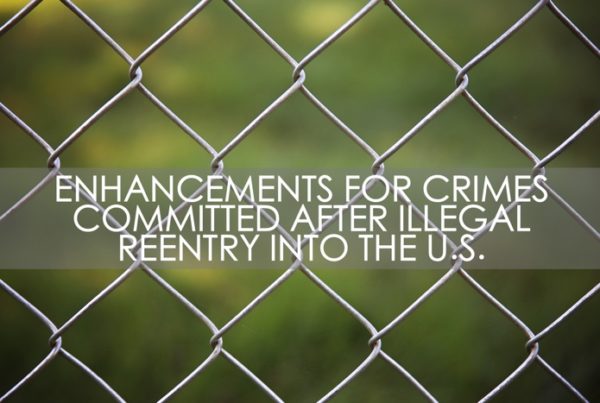Should a defendant charged with possession of drugs be punished for a “dangerous weapon” found at the scene of the drug trafficking and owned by a co-conspirator, when he did not know about the gun in the first place?
 The Federal Fifth Circuit Court of Appeals thinks so. See the Court’s opinion in United States v. Guerrero.
The Federal Fifth Circuit Court of Appeals thinks so. See the Court’s opinion in United States v. Guerrero.
On September 5, 2012, police were investigating a ranch in McAllen, Texas as a possible stash house for drug-trafficking. Officers observed Adrian Rodriguez-Guerrero coming and going from the ranch along with three other men in a caravan. When the officers stopped the caravan, “because the vehicles appeared weighed down,” a dog alerted to the presence of drugs. The police found “boxes of limes with bundles of marijuana concealed among the limes.” The defendants subsequently consented to a search of the McAllen ranch. (I’m always left wondering why people, especially those in possession of drugs, consent to a search.) “There the [police] found…clothing…a loaded shotgun and 125 shotgun shells…plastic cellophane, limes, packing tape…lime boxes, latex gloves, a large scale, and several bundles of marijuana.” In a written statement accepting responsibility, Rodriguez-Guerrero said he was hired to do landscaping at the residence, but was asked to “load the marijuana into a truck at the [ranch]…acknowledg[ing] the [ranch] as a stash house [for drugs].”
Conspiracy to Possess and Distribute Marijuana Enhanced for Possession of a Dangerous Weapon
At trial, he pled guilty to conspiracy to possess with intent to distribute 100 kilograms or more of marijuana, receiving a “guidelines-range sentence of 104 months” imprisonment and four years of supervised release. His sentence included a two-level enhancement for possession of a dangerous weapon—the shotgun found at the McAllen ranch. The district court noted, “[the Court] is not finding Rodriguez-Guerrero possessed the shotgun; rather, it was reasonably foreseeable…that there would be a weapon involved in…the… drug trafficking crime.” The district court added, “the shotgun was a tool of the trade and it [is] reasonably foreseeable to [Rodriguez-Guerrero] that there would have been a weapon, especially [to] a person with the experience that he has in drug trafficking.” Rodriguez-Guerrero appeals to the Fifth Circuit Court of Appeals, stating that there was no evidence to support a finding that either he or a co-conspirator possessed the shotgun—possession which lengthened his prison sentence.
U.S. Federal Sentencing Guidelines Application When a Dangerous Weapon is a “Tool of the Trade”
The United States Sentencing Guidelines Manual provides a two-level sentencing enhancement if “a dangerous weapon was present, unless it is clearly improbable that the weapon is connected with the offense.” U.S.S.G. § 2D1.1(b)(1), cmt. n.11(A). “The government must prove weapon possession by a preponderance of the evidence…[and can do so] by showing a temporal and spatial relationship of the weapon, the drug trafficking activity, and the defendant.” United States v. Zapata-Lara, 615 F.3d 388-90.
Here, the Fifth Circuit Court reasons, the McAllen ranch was a stash house for drug-trafficking, used to “package and transport marijuana.” The ranch was a warehouse to store and move drugs, not a residence “in which drugs were also stored.” Next, several bundles of marijuana were found in the ranch’s master bathroom, making it “plausible [the Court reasons] to find that either Rodriguez-Guerrero or another co-defendant accessed the master bedroom, where the shotgun was found.” Further, the rounds of ammunition suggest that the gun was connected with the drug trade. Lastly, the gun and rounds of ammunition were found on the same day that police observed Rodriguez-Guerrero and the co-defendants at the ranch.
The Court concludes that the “facts identified by the [district] court plausibly establish a temporal and spatial relationship between the weapon, the drug-trafficking activity, and Rodriguez-Guerrero.” The purpose of the sentencing enhancement is to punish because of increased danger and violence when drug traffickers possess weapons. U.S.S.G. § 2D1.1(b)(1), cmt. n.11(A). “The mere fact that a weapon cannot be attributable to any specific drug trafficker does not decrease the danger of violence.” Even though Rodgriguez-Guerrero may not have possessed shotgun, or that he may not have known about the shotgun is irrelevant. The Court states, “there was [sufficient] evidence to support that the weapon must have been possessed by one of the conspirators in furtherance of the conspiracy.”
In short, the Court says that establishing the “temporal and spatial” relationship is enough for possession in these types of drug trafficking cases; and, possession of a weapon could lead to enhanced, or increased prison sentences in federal courts.










